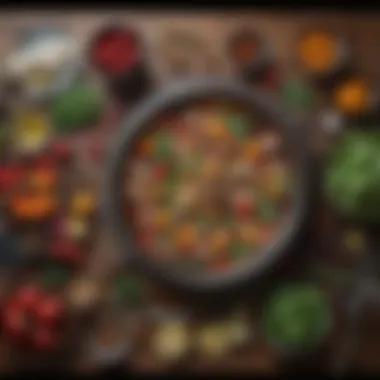New Luck: Mastering Culinary Skills Amidst Chaos


Intro
In the realm of culinary exploration, the notion of 'new luck' has emerged as a compelling theme for those juggling complex schedules yet aspiring to advance their cooking skills. The modern kitchen can sometimes feel overwhelming, and the quest for culinary mastery may seem out of reach. However, harnessing this concept could unveil pathways to more successful meals without sacrificing hours in the kitchen.
By adopting specific strategies and understanding how to leverage available resources, busy individuals can reshape their approach to cooking. We'll highlight important aspects such as effective preparation, time management, and resourcefulness to help readers identify how to create their own 'new luck' in the kitchen.
Recipe Overview
Creative culinary thinking sets distinctive dishes apart. Here, we present a delightful offering that embodies the spirit of simplicity while taking advantage of quick cooking techniques.
- Name: Zesty Lemon Herb Chicken
- Yields: Serves 4
- Prep & Cook Time: 30 minutes
- Difficulty: Easy
- Main Ingredients:
- Chicken breasts
- Fresh lemons
- Garlic
- Olive oil
- Assorted herbs (like rosemary, thyme, or parsley)
- Salt and pepper
Step-by-Step Instructions
Cooking a dish like Zesty Lemon Herb Chicken doesn't have to be time-consuming. Follow these structured steps:
- Ingredient Prep: Start by gathering your ingredients. Wash the chicken breasts under cold water and pat them dry with paper towels. Prepare the garlic by mincing it fine. Zest one lemon and then juice both the zested and another lemon. Measure out the herbs and set aside.
- Marinade Creation: In a bowl, combine the lemon juice, lemon zest, minced garlic, olive oil, chopped herbs, salt, and pepper.
- Marinate the Chicken: Place the chicken breasts in a resealable bag or a shallow dish. Pour the marinade over the chicken, ensuring they are fully coated. For best results, allow it to marinate in the refrigerator for at least 15 minutes.
- Cooking: Preheat your grill or pan over medium-high heat. Once hot, place the marinated chicken onto it. Cook for about 6-7 minutes on each side or until fully cooked (internal temperature should reach 165°F).
- Rest and Serve: Once cooked, let the chicken rest for 5 minutes. This lets the juices redistribute. Finally, slice and serve with a side of your choice.
Time-Saving Strategies
- Batch Cooking: Prepare two portions of chicken simultaneously and store leftovers for lunch or dinner.
- Alternate Methods: Utilize an air fryer for quicker cooking times while achieving a desirable texture.
Nutritional Information
Understanding nutritional content is essential for maintaining a balanced diet. This dish offers:
- Total Calories: Approximately 320 calories per portion
- Protein: 38g
- Fats: 14g
- Carbohydrates: 6g
Key nutrients include a high protein content that supports muscle recovery and beneficial fats from olive oil, contributing to heart health.
Quick Cooking Tips
For multifaceted culinary endeavors:
- Utilize Gadgets: Cooking sous-vide can enhance flavors. An Instant Pot could expedite cooking rice or vegetables alongside the chicken.
- Stay Organized: Prep ingredients in advance. Keeping a clean and orderly workspace leads to greater efficiency.
- Healthier Substitutions: Swap out regular oil with low-calorie cooking spray and use fresh herbs instead of dried when possible for more nutrition.
Related Recipes & Variations
Pair Zesty Lemon Herb Chicken with:
- Garlicky Roasted Potatoes
- Quinoa Salad with Mixed Vegetables
Variations may include adapting to cater to gluten-free or keto dietary models by substituting side dishes effectively. Encourage feedback or recipe variations from readers and their culinary journeys, fostering complications of connections within the community.
Great cooking doesn’t solely rely on random luck but is achieved through careful planning and opportunities for simpler skill development.
Understanding New Luck in Cooking
In today's fast-paced world, every individual looks for ways to optimize their experiences, especially in the kitchen. Understanding the concept of new luck reshapes how one navigates culinary challenges, providing significant insights into achieving successful meals. This idea encourages readers to broaden their definitions of luck and see it not just as a random occurrence but as an outcome closely linked with preparation, execution, and opportunity.
Cooking is often seen as a blend of art and science. Distinguishing between these elements helps identify how our decisions impact results. An exploration of new luck can empower individuals with a fresh perspective, alongside practical skills and insights needed to thrive in various culinary situations.
In recognizing new luck, we can appreciate it as a phenomenon built upon awareness and adaptability. Learning how to leverage existing resources, skills, and even community knowledge is crucial. Cultivating connections with others feeding exchange of ideas creates more profound culinary opportunities.


“Luck is what happens when preparation meets opportunity.”
Analyzing opportunities in the kitchen can lead to rewarding experiences that often outweigh those initially thought challenging. This section feeds directly into more detailed strategies that follow later in the article, all aiming to decisively shape one's cooking journey in new and satisfying manners.
Defining New Luck
New luck in cooking is not merely a concept; it is a paradigm shift. Here, it represents aligning preparedness, creativity, and chance within the odds of culinary endeavors. By understanding and defining new luck, cooks can integrate unique methods for success. This often means altering how they approach recipes, techniques, and meal planning. A significant aspect lies in acknowledging where personal skills can intersect with this idea historically outlined in culinary traditions and newfound opportunities.
An example of new luck might be welcoming the unpredictable nature of seasonal vegetables available at local markets. Instead of clinging to strict recipes, new luck invites us to embrace ingredient availability further than mere necessity. This encompassing mindset instigates exploration leading to distinctly unique flavors and meals, reflecting individual tastes.
Moreover, skilled chefs understand that defining new luck involves analyzing successes and failures together. Each experience becomes an opportunity for growth, thus allowing cooks to recalibrate their approach based on empirical proof gained through practice and reflection.
The Role of Chance in Culinary Success
Chance plays an intrinsic part in the culinary arts, often losing a structured outline in favor of spontaneity. The randomness of flavor pairings can metric surprisingly delightful results, resulting in innovative cooking experiences. However, respecting chance means acknowledging it exists in tandem with preparation and technique.
Creating positive experiences relies on the understanding that as emphasis shifts onto observing nuances in combination, methodological skills still remain significant.
Factors contributing to chance include:
- Ingredient Combination: Unreliable pairs could yield memorable dishes, while complexities of flavors invite exploration.
- Experimental Techniques: Techniques can deviate from norms and lead to unexpected outcomes—some of which trail-blaze into culinary advancements.
- Seasonal Fluctuations: Embracing what is fresh facilitates adaptability, restoring flexibility into meal creations.
Articulating the role of chance in improving cooking reflects the delicate balance each cook cultivates. Achieving desired results requires respect towards both planned and incidental flavors in the kitchen. Understanding this role allows necessary reflex and aptitude adjustment, inviting creativity into rigorous tasks exemplified by a structured cooking recipe.
The relationship between luck and success means harnessing an appreciation of the natural flow within culinary discovery. Accepting its presence cultivates a vibrant cooking community, ultimately leading to richer experience and flavors. As we move to subsequent sections, the importance of strategic implementations of these insights sharpens our understanding of creating and enjoying successful culinary situations.
Preparation: The Key to Harnessing Luck
Preparation is crucial for those wishing to navigate the culinary landscape effectively. In the context of cooking, preparation transcends mere organization; it acts as the groundwork for favorable outcomes. To grasp the influences of luck in culinary experiences, one must first recognize that luck tends to favor the well-prepared. This section discusses significant aspects like meal planning and the establishment of a cooking schedule, which act as foundational elements in elevating culinary endeavors.
Importance of Planning Meals
Planning meals is essential for maximizing both time and resources in the kitchen. It is about more than just knowing what to cook; it encompasses thoughtful ingredient selection and nutritional balance. Benefits include reduced stress levels, enhanced creativity, and minimizing food waste.
- Reduced Anxiety: When meal plans are organized, fewer last-minute decisions are needed, leading to a calmer cooking experience.
- Economical Choices: Careful planning allows for bulk buying of ingredients, which can reduce grocery bills over time.
- Balanced Meals: Planning facilitates that the meals adhere to nutritional guidelines, ensuring a well-rounded diet that benefits physical health.
By mapping out the week or month in advance, it becomes simpler to identify trends or new culinary avenues to explore. Easy access to information about recipes can significantly simplify this process.
Creating a Cooking Schedule
Creating a cooking schedule also plays a vital role in harnessing luck. A schedule acts as your guide, setting aside time specifically for cooking-related activities, thus optimizing resources and reducing time conflicts.
A structured culinary schedule emphasizes:
- Consistency: Frequent time slots for cooking can help develop routines that enhance skill through practice.
- Flexibility: A schedule should retain the ability to adapt to last-minute changes or opportunities, ensuring spontaneity does not hinder preparation.
- Efficiency: Consciously setting aside blocks of time can aid in multi-tasking kitchen activities, effectively utilizing every moment.
Using tools like calendars or apps to stay on track not only helps tailor power strategies in the kitchen, but also opens the door for new culinary experiences.
"Preparation is not just the beginning of success; it makes chance work to your benefit."
By creating an intentional, preparatory foundation centered around meal planning and scheduling, one establishes a conducive environment to draw in frequencies of luck that enhance culinary exploration.
Resource Management in the Kitchen
Effective resource management in the kitchen can significantly impact the success of culinary exploration. This aspect involves making optimal use of tools, ingredients, and time. Not only does it enhance efficiency, but it also fosters creativity and experimentation. Understanding how to manage resources improves both the quality of dishes and the overall cooking experience.
Utilizing Kitchen Tools Effectively


Utilizing kitchen tools effectively is essential for achieving cooking success. Having the right tools can streamline processes and increase productivity. Here are some tips on effective usage:
- Invest in Multi-functional Tools: Select tools that can perform various tasks. For example, an immersion blender can puree soups, mix smoothies, and even whip cream.
- Organize Tools for Ease of Access: Keep frequently used tools within arm’s reach to avoid disruption during cooking. Categorizing tools such as knives, measuring cups, and pans helps save time.
- Maintain Your Equipment: Regular maintenance prolongs the life of your tools. Keep knives sharp and clean, and monitor other tools for wear and tear.
Having an organized and well-stocked kitchen allows cooks to channel their energy into creativity rather than spending cherish time search for an essential tool.
Sourcing Quality Ingredients
Sourcing quality ingredients is integral to successful culinary outcomes. The right ingredients ultimately dictate flavor, texture, and presentation. Focus on these guidelines for sourcing:
- Understand Seasonality: Familiarizing yourself with seasonal ingredients yields the best results. Using fresh, in-season produce often offers superior flavor and nutritional value.
- Purchase from Local Sources: Whenever possible, buy ingredients from local farmers’ markets or specialty shops. They usually sell higher-quality products compared to mass-produced store options.
- Always Check Labels: When sourcing packaged ingredients, pay attention to the expiration dates and sourcing. Quality often declines with time, impacting final dish quality.
Attention to ingredient quality can elevate a cooking experience. As with tools, carefully chosen components can foster greater creativity in whatever culinary landscape is being explored.
Quality inspiration arises not only from visible outcomes. It springs from the experience of cooking effectively with the best ingredients and tools.
Techniques to Improve Cooking Outcomes
Improving cooking outcomes is fundamental in achieving consistent and enjoyable culinary experiences. This section gives emphasis on techniques that elevate culinary effectiveness, which can profoundly influence the experience of cooking and the subsequent meals produced. Techniques span both the foundational skills you must master, as well as the innovative approaches that keep the cooking experience vibrant and engaging. By focusing on these techniques, one can hone one’s skills and make the kitchen feel less like a chore and more like a creative outlet.
Mastering Basic Cooking Skills
Basic cooking skills serve as the backbone of culinary proficiency. These skills, often learned through practice and continued effort, categorize everything from knife skills to proficiently understanding how heat alters ingredients. For individuals exploring the concept of new luck, having mastery over basic skills can reveal opportunities during the cooking journey. Some essential skills to focus on include:
- Knife Handling: Knowing how to hold a knife and execute fundamental cuts such as julienne, dice, and chiffonade can make the preparation process faster and more efficient.
- Sautéing: Mastery over sautéing techniques can add better texture and flavor to ingredients. Understanding when to add garlic and when to let vegetables develop their flavor can change cooking outcomes efficiently.
- Baking Basics: Developing skills in areas like measuring dry versus liquid ingredients, understanding oven temps, and fundamentals of making doughs leads to better baked goods.
Here, repetition is key. Frequent practice of fundamental techniques builds muscle memory and improves confidence in the kitchen. This not only reduces kitchen-ware hate, or the dislike of using tools, but promotes familiarity in handling and cooking diverse ingredients.
Innovative Cooking Methods
Innovation in cooking involves being open to using various cooking methods to yield favorite results with efficiency. As we often become limited to our routine styles, creating bites of happiness around the dining table can drive us towards exploring a breadth of innovative techniques. Methods of interest may include:
- Sous Vide: This technique involves vacuum-sealing foods and cooking them evenly in a water bath at precise temperatures. It can yield tender proteins, respecting the version of luck and chance qualities in preparation.
- Fermenting: Incorporating controlled fermentation can lead to a greater range of flavors and improve nutritional profiles of certain dishes, like kimchi or ◦◦miso. This method showcases the beauty of blending techniques to awe diners.
- Pressure Cooking: Using a pressure cooker dramatically alters the cooking times of meals while providing impressive flavor profiles that conveniently come to life in numerous dishes.
Challenging oneself by employing these innovative methods can produce unusually satisfying results with relatively minimal effort once the basics have been mastered. As experience builds, so might the opportunity to incorporate unique pairings of skills and ingredients that entice, surprise, and indeed, improve luck in daily cooking tasks.
Mastering basic skills unlocks potential for greater creativity in cooking.
Building upon strong core techniques combined with a willingness to venture into innovative methods create a sound basis for producing remarkable meals.
By exploring favored techniques and finding your rhythm in the kitchen, culinary enthusiasts can refine their approaches. Hence, success in cooking can become less reliant on chance and more an element of diligent preparation.
Identifying Opportunities in the Kitchen
Identifying opportunities in the kitchen is a significant aspect of navigating newfound culinary experiences. In a fast-paced life, making timely observations can lead to improved skills and memorable meals. Its centrality lies in understanding how our choices and awareness can transform little moments into larger culinary successes, ultimately shaping our experiences in food preparation and taste.
By harnessing opportunities, cooks seek to blend creativity with practical skills. This blend can unlock unexpected results, fostering a unique environment in the kitchen. Here are several key reasons why recognizing such opportunities is essential:
- Encouraging Innovation: Embracing trends or seasonal ingredients promotes creativity and encourages alternative cooking methods.
- Enhancing Resourcefulness: Discovering opportunities leads to better utilization of what’s available, avoiding waste.
- Boosting Confidence: Successful experimentation can improve confidence in one's skills and abilities, making cooking a more enjoyable endeavor.
Recognizing Trends in Cooking
Staying in tune with trends allows cooks to connect with broader culinary movements. Learning about recent culinary trends enhances the ability to adapt ideas into personal cooking practices. Emerging trends often arise from shifts in consumer preferences, encouraging cooks to consider healthier or more sustainable options. Here are some ways to stay aware of trends:
- Follow Food Blogs: Engaging with multiple sources can provide insights into new ingredients and techniques.
- Social Media: Platforms like Instagram and Reddit serve as hotbeds for food ideas and experimenting with different diets.


Recently, plant-based cuisine has gained popularity. Recognizing this shift can lead to exploring new recipes, focusing on vegetables, legumes, and promoting principles of sustainability.
Experimenting with Flavors and Techniques
Experimentation is a pre-requisite for creative cooking. Trying unfamiliar flavors can challenge the palate and prepare one for cooking versatility. This section empowers cooks to adjust basic frameworks, moving beyond traditional approaches.
- Seasonal Pairings: Use seasonal ingredients to create combinations that highlight the fresh aspects of different foods, such as pairing lemon with herbs for a refreshing twist.
- Cooking Methods: Experiment with various cooking techniques like sous-vide or smoking to create distinct taste profiles.
For example, adapting a classic Italian dish with local spices or herbs introduces diners to delightful experiences. Going beyond familiar tastes keeps culinary routines engaging and relevant.
The Impact of Mindset on Cooking Success
The connection between mindset and cooking outcomes is vital in this culinary exploration. When one approaches cooking with the right mental framework, it enhances not just skill but the overall experience in the kitchen. A positive mindset contributes significantly to creativity, problem-solving, and resilience during the cooking process. It establishes an environment where experimentation feels welcome and where even mistakes become chances to learn.
Cultivating a Positive Cooking Environment
Creating a supportive atmosphere in the kitchen is essential. A well-organized space can elevate the cooking experience, assuring focus and clarity. Here are several ways to cultivate this environment:
- Declutter: A clean workspace allows one to concentrate fully on the task at hand. It helps lessen distractions and reduces stress.
- Personal Touches: Add items that inspire creativity, like images of favorite dishes or plants that bring light.
- Structured Setup: Ensuring that tools and ingredients are arranged systematically creates a smooth workflow, making cooking less daunting.
A positive cooking environment fosters experimentation. Ideas can flourish when you feel relaxed and comfortable.
By paying attention to such details, the mind is free to explore new flavors and techniques.
Building Confidence through Practice
Building confidence in the kitchen starts with regular practice. Confidence grows from your comfort level when engaging with various cooking methods. Here are some elements to consider for fostering confidence:
- Start Small: Tackle simple recipes before moving on to more complex dishes. This helps to overcome feelings of intimidation.
- Keep Learning: Watching cooking tutorials or attending workshops can open up a world of possibilities. Manuscripts and online resources can also provide insights and proven methods.
- Pairing Feedback: Both positive and constructive feedback from peers or experienced cooks greatly aids development. It underscores one’s progress while identifying areas for improvement.
As skill improves through practice, chefs often find their reservations fade. The kitchen then transforms into a space for growth and joy.
Sharing and Learning from Experiences
The culinary journey often extends beyond the confines of one’s own kitchen. Sharing and learning from experiences is essential in enriching our cooking skills and expanding our horizons. When we collaborate with others, we gain new perspectives and techniques that can alter our approach to food preparation. This synergy allows cooks to feltl the diverse tastes and methods that characterize various cuisines. By engaging in this exchange, one can effortlessly morph individual cooking styles into collective masterpieces.
Collaboration with fellow cooks brings multiple benefits. First, sharing tips and strategies can save time and avoid repeated mistakes. A person may reach culinary breakthroughs through asking for advice or joint experimentation. Cooks learn from the successes and failures of others, potentially shortening the learning curve raises their skill sets to new levels without a significant time investment.
Not only can collaboration enhance the cooking process itself, but it can also nurture a sense of community. Bonding over shared ingredients or recipes can lead to traditions that promote ongoing learning. Social interactions centered around cooking naturally extend to meals that culminate these art forms. While discussing different flavors and dish presentations fosters mutual respect and acknowledgment of each person’s strengths in the kitchen.
Culinary Resources at BigChopz
Culinary resources presented by BigChopz play a vital role in a fostering a productive cooking experience. This section explores how these resources contribute to convenient culinary exploration. Whether you are a novice cook or a seasoned chef, having access to the right tools and information can drastically impact your kitchen efficiency.
BigChopz offers not just recipes but a compendium of strategies that can streamline meal preparation. With resources that emphasize quickness without sacrificing quality, cooks of all skill levels can successfully navigate the often hectic landscape of daily food preparation. The focus is on simplicity, so even busy individuals can find feasible and enjoyable ways to cook.
Quick Recipes for Busy Lifestyles
In the modern world, many people struggle to find time to cook. BigChopz recognizes this and provides quick recipes tailored for busy lifestyles. Each recipe is carefully designed to minimize step and time, ensuring that cooking fits easily into anyone's schedule. These quick recipes employ easily available ingredients, often making them budget-friendly as well.
When searching for efficiency, certain strategies stand out:
- One-Pan Meals: Combining most of the cooking process into one pan significantly cuts down on dish cleanup and cooking time.
- Make-Ahead Options: These recipes allow you to prepare a meal in advance. Items like casseroles or marinated proteins can save time on busy days.
- Stir-Frys: Quick cooking methods allows a variety of ingredients to be fried simultaneously, capturing flavor without lengthy preparation.
- Use of Appliances: Slow cookers or pressure cookers provide an ideal way to prepare meals with minimal oversight.
By applying quick recipes tailored to your life, you will be better able to create good meals without excessive time commitment.
Cooking Tips to Enhance Efficiency
To navigate your culinary journey more smoothly, BigChopz also offers valuable cooking tips for efficiency. These carry the potential to freeze the amount of time spent on meals without sacrificing the quality of the cuisine produced.
- Prepping Ingredients: With proper planning, having pre-chopped vegetables and seasoned meats ready ahead of cooking times can drastically speed things up.
- Mise en Place: Organizing and measuring ingredients ahead of time streamlines the cooking process.
- Utilizing Technology: Introduce apps that remind you of steps and necessary prep work, or timers for cooking durations.
- Batch Cooking: Preparing large quantities for the week makes it easy to serve few meals quickly. It's efficient handling and leads to easier meal distribution.
These tips, when implemented, enhance effectiveness in the kitchen, significantly lowering stress levels while elevating daily cooking trade. Because who has the time to waste amid demanding schedules? Utilizing culinary resources at BigChopz ensures that every cook can maximize their potential.







